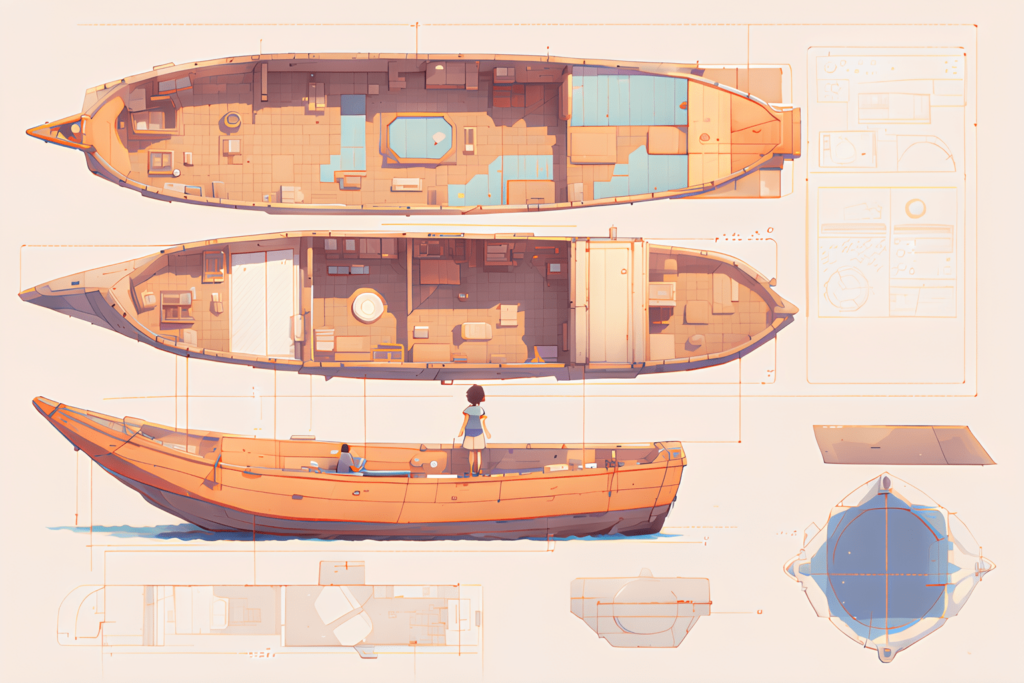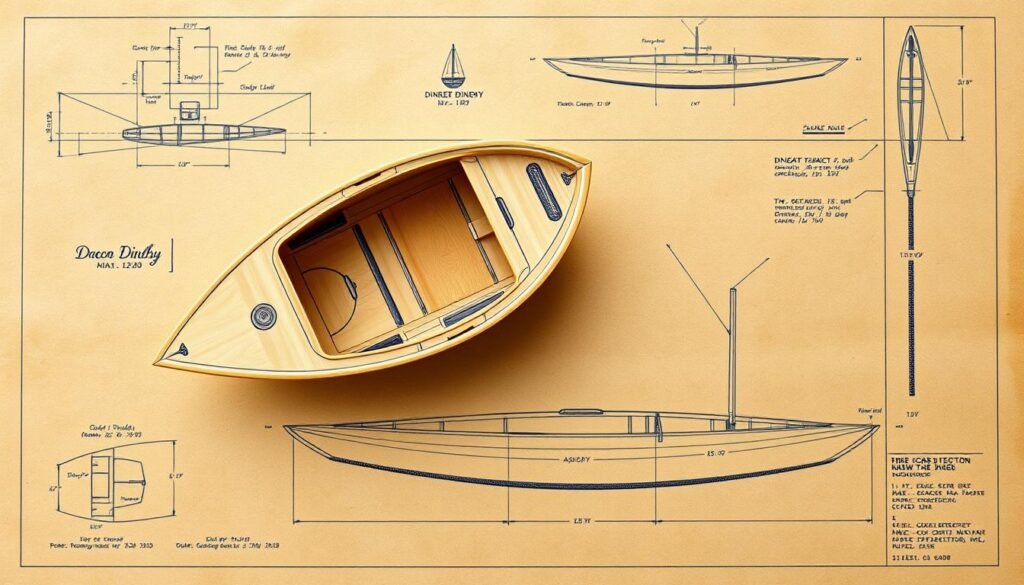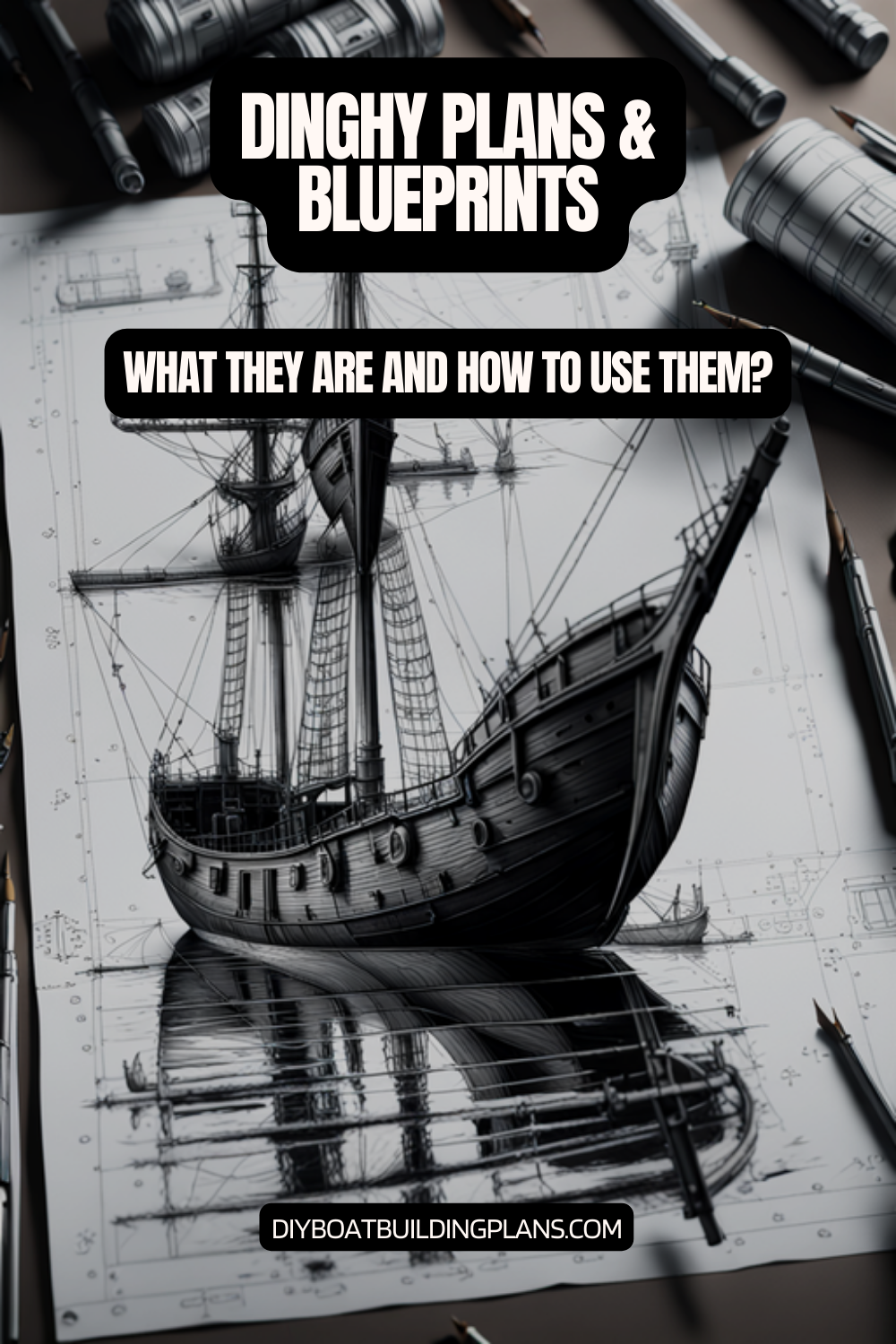Are you ready to turn your weekend hobby into a nautical dream? What if building your own boat was easier and cheaper than you thought?
The DIY world of dinghy plans and boat guides has changed small craft building. In the 1960s and 1970s, sailing dinghies became a symbol of fun and freedom. They captured the hearts of weekend sailors.
Today, boat lovers can make beautiful watercraft using simple plywood methods. You can build everything from small 12-foot sailboats to big 15.5-foot canoes. The choices are endless.
Whether you’re an experienced sailor or just starting, DIY dinghy plans are a fun way to explore the sea. Prices range from $36 to $100. This makes building your own boat a dream come true for many.
Key Takeaways – Dinghy Plans & Blueprints
- DIY boat building is more accessible than ever before
- Plywood construction offers affordable and lightweight options
- Boat plans range from $36 to $100 for various skill levels
- Building your own dinghy can be a rewarding weekend project
- Modern techniques make boat construction easier for beginners

Introduction to DIY Dinghy Building
Starting a DIY dinghy building project is exciting. It brings creativity, personal pride, and a chance for maritime adventure. Today’s dinghy design plans make building boats easy for everyone.
DIY boatbuilding kits have changed the game for boat lovers. What was hard before is now fun and doable for many.
Why Choose a DIY Approach?
- Cost-effective alternative to purchasing pre-made boats
- Complete customization of your watercraft
- Deep understanding of boat construction
- Satisfaction of creating something with your own hands
Benefits of Building Your Own Dinghy
Building a dinghy is more than making a boat. It’s about creating an experience. The Oz Goose sailing dinghy shows how DIY plans can lead to amazing results. It can carry 1-2 adults and performs well.
“The joy of sailing is amplified when you’ve built the boat with your own hands.” – Sailing Enthuasiast
| Dinghy Plan | Cost | Key Features |
|---|---|---|
| Viola 14 Sailing Canoe | $100 | Stable, Easy Transport |
| Goat Island Skiff | $100 | Light, Fast, Beautiful |
| BETH Sailing Canoe | $100 | Historic Design, Racing Potencial |
With modern DIY boatbuilding kits, most people can finish a project in 60-90 total hours. This includes prep and finishing. The average cost is around $300, making it a fun and affordable hobby.
Types of Dinghies You Can Build
Exploring DIY boat building opens exciting water adventures. You can choose from rowing to sailing with many wooden dinghy plans. Knowing the different types helps pick the right project for your sea trips.
Rowing Dinghies: Simplicity and Tradition
Rowing dinghies are great for beginners. They focus on human power and are simple to build. Popular designs include:
- Eastport Pram – A compact and versatile rowing vessel
- Tenderly Dinghy – Known for excellent stability
- Small craft designs measuring 8-12 feet in length
Sailboats: Wind-Powered Adventure
Sailing fans will find many options in sailing dinghy blueprints. Designs range from easy to advanced. Some top picks are:
- Goat Island Skiff – A popular choice for recreational sailors
- Oz Goose – Lightweight and easy to transport
- PassageMaker – Versatile design adaptable for rowing and sailing
Motorized Dinghies: Power and Flexibility
Motorized dinghy plans offer a powered option. The Holly Point Skiff is a great example of a motorized design. It’s both fast and practical.
*The beauty of DIY dinghy building lies in the ability to create a vessel that matches your exact needs and skill level.*
When picking a dinghy type, think about use, skill, and resources. The 1960s and 1970s sailing boom showed boat building is for everyone.
Essential Tools and Materials Needed
Starting a dinghy building project needs careful planning and the right tools. Manuals for building dinghies stress the importance of quality tools and materials. This ensures a successful build, whether using DIY kits or custom designs.
Boatbuilding needs a small set of tools, with stitch and blue needing even fewer. It’s important to choose quality and versatile tools.
Basic Tools for Construction
- Cordless drill with various drill bits
- Random orbital sander (professional boatbuilders recommend high-quality models)
- Japanese cross-cut saw for precision cutting
- Utility knife for marking and cutting thin materials
- Chisels and planes for detailed woodwork
- Wood rasp and single-cut file for shaping
Recommended Materials
| Material | Purpose | Recommended Type |
|---|---|---|
| Marine-grade plywood | Primary boat structure | 1.2 cm thickness recommended |
| Epoxy resin | Sealing and bonding | High-quality marine-grade |
| Fiberglass cloth | Reinforcement | Lightweight marine grade |
| Silicone sealant | Structural reinforcement | Marine-grade waterproof |
Safety Gear for DIY Projects
Safety is key in any DIY boatbuilding kit project. You’ll need:
- Safety glasses or protective eyewear
- Dust masks or respirators
- Work gloves
- Ear protection when using power tools
“In tools, you get what you pay for” – A wisdom shared by experienced boatbuilders
Pro tip: Spend on quality tools that last. A carbide scraper for removing epoxy drips and good pipe clamps can save time and improve your dinghy’s finish.
Understanding Dinghy Plans and Blueprints
Exploring dinghy design plans needs a sharp eye and a grasp of technical details. Sailing dinghy blueprints are detailed guides. They show how to turn materials into a boat ready for the sea.

- Sail plan
- Arrangement plan
- Hull lines
- Construction drawings
What to Look for in a Blueprint
When looking at sailing dinghy blueprints, pay attention to important design parts. These parts make the boat work well and look good:
- Sheerline curvature
- Stem and stern shape
- Rig type specifications
- Dimensional accuracy
Common Terms to Know
Knowing boat design terms helps you understand dinghy plans better:
| Term | Definition |
|---|---|
| Lofting | Scaling and plotting boat hull measurements |
| Chine | The line where the side and bottom of a boat meet |
| Transom | The flat or nearly flat stern section of a boat |
“A good blueprint is the blueprint of a sailor’s dream.” – Anonymous Boat Designer
Digital dinghy design plans are usually in PDF format. They have 4-8 detailed sheets. Some plans fit on standard paper, while others need large-format printing for details.
Pro Tip: Always check the scale and measurements before starting your dinghy project. This ensures accuracy and success.
Unlock the secrets to building your dream boat with MyBoatPlans! With detailed plans for over 518 boats and expert video tutorials, you’ll have everything you need to create your perfect vessel. Click here to begin your journey!
Step-by-Step Guide to Building Your Dinghy
Starting a dinghy building project needs careful planning and precise steps. Building small crafts requires attention to detail and a systematic approach. This guide will help you through the key steps of making your own watercraft, turning raw materials into a working vessel.
Planning and Preparation
Good dinghy building starts with thorough preparation. First, collect all your materials carefully. Make sure you have everything before you begin:
- 6mm marine-grade plywood
- Structural epoxy (recommended: System Three Epoxy)
- Fiberglass cloth (6 oz weight)
- Electrical fence wire for stitching
- Basic woodworking tools
Cutting and Shaping Materials
Accuracy is key in small craft building. Make a detailed cutting plan to avoid waste and ensure precise measurements.
| Material | Quantity | Purpose |
|---|---|---|
| Douglas Fir Plywood | 3 sheets | Hull sides, bottom, transom |
| Fiberglass Tape | 4-inch width | Seam reinforcement |
| Wire | 1/2 inch | Temporary stitching |
“Measure twice, cut once” – A fundamental rule in dinghy building that saves time and materials.
Assembling Your Dinghy
The assembly process usually uses the stitch and glue method. This method is simpler for DIY builders:
- Create temporary wire stitches to hold panels
- Apply epoxy to permanent seams
- Remove temporary stitches
- Sand and finish surfaces
Building a dinghy can take 40-60 hours. Painting adds another 10 hours. The total cost is about $300, not including a motor or advanced tools.
Tips for Personalizing Your Dinghy
Turning your DIY dinghy into a unique watercraft is exciting. Personalization lets you add your style and needs to your DIY Dinghy Plans & Blueprints.
Customizing your boat is like creating a piece of art. It shows your personality and the adventures you have on the water.
Choosing Colors and Finishes
Choosing the right color and finish makes your dinghy stand out. Think about these important points:
- Marine-grade paints with UV resistance
- Durable exterior varnishes
- Colors that match the water
- Coatings to protect against the weather
“Every brushstroke tells a story of personal craftsmanship.”
Adding Custom Features
Custom features make your boat special. Here are some ideas from professional boat builders:
- Integrated storage compartments
- Custom fishing rod holders
- Special rigging for sailing
- Ergonomic seating modifications
About 60% of boaters do DIY projects. These can increase your boat’s value by 20%.
| Customization Category | Cost Allocation |
|---|---|
| Aesthetics | 30% |
| Functionality | 25% |
| Tech-Savvy Upgrades | 20% |
| Safety Measures | 15% |
Remember, your dinghy is more than a boat—it’s a reflection of your passion for maritime adventures.
How to Ensure Stability and Safety
Building a stable and safe dinghy needs careful planning and focus on key design elements. Small craft construction requires precision and knowledge of safety principles. These principles protect the boat and its passengers.
Dinghy construction manuals highlight important design factors for stability:
- Hull shape and width
- Weight distribution
- Center of gravity
- Material selection
Design Fundamentals for Enhanced Stability
The hull’s shape is key to balance. A wider beam helps with stability, and the right hull depth prevents too much rocking.
| Stability Factor | Recommended Specification |
|---|---|
| Hull Length | 3.5 ft (1.050m) |
| Hull Beam | 8″ (200mm) |
| Hull Depth | 10″ (258mm) |
| Maximum Weight | 5 lbs (using 3-4mm Gaboon Plywood) |
Essential Safety Features to Incorporate
To boost safety in small craft construction, add these key features:
- Built-in flotation tanks
- Non-slip surfaces
- Secure rigging systems
- End buoyancy compartments
Safety isn’t about eliminating risk, but managing it intelligently through thoughtful design and preparation.
Experienced builders know that practice and familiarity are as vital as technical specs. Always test your dinghy in safe areas before tackling rougher waters.
Maintenance Tips for Your DIY Dinghy
Keeping your wooden dinghy in top shape needs dedication and regular care. DIY boatbuilding kits are a big investment. So, it’s key to protect your boat for long-term fun and performance.
Maintaining your DIY dinghy involves several key strategies. These ensure its longevity and function. Proper care keeps your handcrafted vessel beautiful and strong.
Download over 500 Boat Plans. Click on the link below.
-->Click Here<--
Regular Cleaning and Care
- Clean the wooden surfaces weekly using marine-approved cleaning solutions
- Inspect for signs of wear or damage after each use
- Apply protective marine varnish every 2-3 months
- Rinse thoroughly after saltwater exposure
Essential Maintenance Tools
For effective wooden dinghy plans maintenance, gather these critical tools:
- Marine-grade sandpaper
- Protective varnish
- Wood filler
- Sealants
- Soft cleaning cloths
Repairing Common Issues
DIY boatbuilding kits can face typical wear problems. These need quick attention:
“Prevention is always cheaper than repair in boat maintenance.”
- Address small cracks immediately with epoxy
- Check for wood rot in critical areas
- Repair minor hull damages quickly
- Ensure proper ventilation to prevent decay
Consistent maintenance will keep your wooden dinghy sailing smoothly for years to come.
Eco-Friendly Dinghy Building Practices
Today, making boats in a green way is key for DIY fans. They focus on building dinghies that are good for the planet. This means using less waste and being kind to nature.
- Use wood from forests that are managed well
- Choose materials that have been recycled or reused
- Go for epoxy and finishes that don’t harm the air
- Make boats that use as little material as possible
Sustainable Materials for Dinghy Construction
Modern builders are looking at new materials that are good for the planet. Plywood from sustainable forestry, recycled plastics, and composites are great options. They help reduce the harm to our oceans.
“Sustainability in boat building isn’t just about materials—it’s about creating vessels that respect our marine ecosystems.” – Maritime Design Association
Minimizing Project Waste
Planning well can cut down on waste a lot. Using precise cuts, picking materials wisely, and designing smart can help. This way, DIY builders can make a difference for the environment.
Recent data shows good news for green boat design:
- 9 new eco-friendly dinghy designs added between 2023-2024
- 50% increase in motor-type dinghies with sustainable materials
- 20 new product designs featuring environmentally conscious approaches
By using these green methods, DIY boat builders can make beautiful, useful dinghies. They also help protect our planet.
Resources for DIY Dinghy Enthuisiasts
Starting a DIY dinghy project is thrilling for boat lovers. The right tools and guides are key to success.
Online Communities and Forums
Digital spaces are full of help for boat builders. They share lots of tips and advice:
- Wooden Boat Magazine Forum
- Small Craft Advisor Community
- Reddit’s r/Boatbuilding Subreddit
- Facebook Groups for DIY boat making
“The best learning happens through shared experiences and collective knowledge.” – Professional Boat Builder
Recommended Books and Guides
There are many great books to help with your project:
- Boat Building with Plywood by Glen L. Witt
- Dinghy Building Made Simple by Richard Creagh
- The Boatbuilder’s Apprentice by Greg Rossel
YouTube Channels for Visual Learning
For those who learn better by watching, here are some great YouTube channels:
- Duckworks Boat Builders Supply
- Small Boat Restoration
- Wooden Boat Magazine Channel
- Boatcraft Northwest
Whether you’re new or have experience, these resources will guide you. They’ll help you build the boat you’ve always wanted.
Frequently Asked Questions about Dinghy Blueprints
Starting a DIY dinghy project is both thrilling and daunting for beginners. It’s important to know the common questions and hurdles to overcome. This knowledge is key to successfully creating your own dinghy design plans.
Common Concerns for Beginners
New boat builders often face similar questions when building a dinghy. Let’s look at some of the most common worries:
- Selecting the right dinghy design plans
- Estimating build time and budget
- Understanding technical blueprint requirements
- Identifying necessary tools and materials
Solutions for Troubleshooting Issues
Working on DIY dinghy plans requires smart problem-solving. Here are some practical solutions to common problems:
| Challenge | Recommended Solution |
|---|---|
| Complex Blueprint Reading | Join online boatbuilding forums, watch tutorial videos |
| Tool Limitations | Rent or borrow specialized equipment |
| Material Selection | Consult local marine supply stores |
| Budget Constraints | Start with smaller, less expensive dinghy designs |
“The key to successful DIY dinghy building is patience, preparation, and continuous learning.” – Professional Boat Builder
Beginners should remember that dinghy design plans are learning tools. Start with simpler projects, seek advice from experienced builders, and gradually build your skills.
For those considering DIY dinghy plans, preparation is essential. Research thoroughly, connect with community experts, and approach your project with enthusiasm and realistic expectations.

Conclusion: Start Your DIY Dinghy Journey Today
Starting a DIY dinghy project is more than just building a boat. With over 500 boat plans to download, making your own watercraft is possible. DIY plans let you turn materials into a unique and useful boat.
Building a dinghy needs passion, hard work, and good planning. Boat building guides say to use top-notch materials and follow the plans carefully. Whether you want a rowing or sailing dinghy, knowing how to build it is key.
The journey of making a dinghy is more than just building. It’s about learning new skills, understanding boat design, and feeling proud of your creation. Every step, from picking a plan to applying paint, makes you a better boat builder.
Take the First Step
Your maritime adventure begins now. Look for DIY dinghy plans, get the right tools, and be ready to learn. Every great boat builder started with curiosity, determination, and a dream to sail in their own boat.
FAQ – Dinghy Plans & Blueprints
How difficult is it to build a dinghy as a beginner?
Building a dinghy is easy for beginners with modern methods like stitch and glue. Start with simple designs like the Eastport Pram or Oz Goose. These need basic tools and easy-to-follow instructions.
Many designers offer help and blueprints for new builders. This makes it easier to get started.
What tools do I need to build a DIY dinghy?
You’ll need a jigsaw, cordless drill, sander, rulers, and pencils. Safety gear like protective eyewear, gloves, and masks is also important. Most DIY projects can be done with tools you might already have at home.
How much does it cost to build a DIY dinghy?
Costs vary based on design and materials. DIY dinghies usually cost between $500 and $2,000. Building your own can save a lot compared to buying a pre-made boat.
Costs depend on the wood type, material quality, and design complexity.
How long does it take to build a dinghy?
Building time varies with your skill and design complexity. Simple rowing dinghies might take 50-100 hours. More complex sailboats could need 100-200 hours.
Weekend builders usually finish in a few weeks to months.
What type of dinghy should I build for my first project?
Beginners should start with rowing dinghies like the Eastport Pram or simple sailboats like the Oz Goose. These are easy to build and require less skill. Choose based on your use and skill level.
What materials are best for building a dinghy?
Marine-grade plywood is the top choice for DIY dinghies. You’ll also need epoxy resin, fiberglass cloth, and marine-grade fasteners. Modern materials like marine epoxy make building easier and durable.
Can I customize my DIY dinghy?
Yes! DIY building lets you customize a lot. You can pick colors, add features like storage, or change the rigging. Many designs are flexible for personal touches while keeping performance good.
Where can I find dinghy plans and blueprints?
Check out Classic Wooden Boat Plans, online communities, and designers like Michael Storer. The Oz Goose Group on Facebook is great for advice and plans. Books and videos are also good sources.
Is building a dinghy environmentally friendly?
DIY dinghy building can be green by using sustainable wood, recycled materials, and reducing waste. Modern designs aim for lightness and efficiency, needing less material and energy.
What safety considerations should I keep in mind?
Focus on hull stability, add flotation, use non-slip surfaces, and ensure proper rigging for sailboats. Always wear safety gear and choose a design that fits your skill and use.



